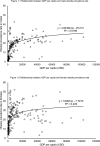Significantly different roles of economic affluence in sex-specific obesity prevalence rates: understanding more modifications within female body weight management
- PMID: 36130963
- PMCID: PMC9492695
- DOI: 10.1038/s41598-022-19633-3
Significantly different roles of economic affluence in sex-specific obesity prevalence rates: understanding more modifications within female body weight management
Abstract
Socioeconomic status has been associated with obesity prevalence increase in both males and females worldwide. We examined the magnitude of the difference between the two relationships and explored the independence of both relationships. Country specific data on gross domestic product (GDP) per capita, sex-specific obesity prevalence rates, urbanisation, total calories availability and level of obesity, genetic background accumulation (measured by the Biological State Index, Ibs) were obtained for 191 countries. Curvilinear regressions, bivariate and partial correlations, linear mixed models and multivariate linear regression analyses were used to examine the relationship between GDP and obesity prevalence rates in males and females respectively. Fisher's r-to-z transformation, F-test and R2 increment in multivariate regression were used to compare results for males and females. GDP significantly correlated with sex-specific obesity prevalence rates, but significantly more strongly with male obesity prevalence in bivariate correlation analyses. These relationships remained independent of calories availability, Ibs and urbanization in partial correlation model. Stepwise multiple regression identified that GDP was a significant predictor of obesity prevalence in both sexes. Multivariate stepwise regression showed that, when adding GDP as an obesity prevalence predictor, the absolute increment of R2 in male fit model (0.046) was almost four (4) times greater than the absolute increment in female model fit (0.012). The Stepwise analyses also revealed that 68.0% of male but only 37.4% of female obesity prevalence rates were explained by the total contributing effects of GDP, Ibs, urbanization and calories availability. In both Pearson's r and nonparametric analyses, GDP contributes significantly more to male obesity than to female obesity in both developed and developing countries. GDP also determined the significant regional variation in male, but not female obesity prevalence. GDP may contribute to obesity prevalence significantly more in males than in females regardless of the confounding effects of Ibs, urbanization and calories. This may suggest that aetiologies for female obesity are much more complex than for males and more confounders should be included in the future studies when data are available.
© 2022. The Author(s).
Conflict of interest statement
The authors declare no competing interests.
Figures
Similar articles
-
Relaxed natural selection contributes to global obesity increase more in males than in females due to more environmental modifications in female body mass.PLoS One. 2018 Jul 18;13(7):e0199594. doi: 10.1371/journal.pone.0199594. eCollection 2018. PLoS One. 2018. PMID: 30021019 Free PMC article.
-
Associations of economic and gender inequality with global obesity prevalence: understanding the female excess.Soc Sci Med. 2012 Aug;75(3):482-90. doi: 10.1016/j.socscimed.2012.03.029. Epub 2012 Apr 21. Soc Sci Med. 2012. PMID: 22580078
-
Prostate Cancer Incidence is Correlated to Total Meat Intake– a Cross-National Ecologic Analysis of 172 Countries.Asian Pac J Cancer Prev. 2018 Aug 24;19(8):2229-2239. doi: 10.22034/APJCP.2018.19.8.2229. Asian Pac J Cancer Prev. 2018. PMID: 30139230 Free PMC article.
-
Cataract Surgical Rate and Socioeconomics: A Global Study.Invest Ophthalmol Vis Sci. 2016 Nov 1;57(14):5872-5881. doi: 10.1167/iovs.16-19894. Invest Ophthalmol Vis Sci. 2016. PMID: 27802517 Review.
-
Radiation Therapy Availability in Africa and Latin America: Two Models of Low and Middle Income Countries.Int J Radiat Oncol Biol Phys. 2018 Nov 1;102(3):490-498. doi: 10.1016/j.ijrobp.2018.06.046. Epub 2018 Jul 10. Int J Radiat Oncol Biol Phys. 2018. PMID: 30005945 Review.
Cited by
-
Sensitivity and Specificity of Anthropometric Indices in Identifying Obesity in Women over 40 Years of Age and Their Variability in Subsequent Decades of Life.Biology (Basel). 2022 Dec 12;11(12):1804. doi: 10.3390/biology11121804. Biology (Basel). 2022. PMID: 36552313 Free PMC article.
-
Exploring the multifaceted factors influencing overweight and obesity: a scoping review.Front Public Health. 2025 Apr 9;13:1540756. doi: 10.3389/fpubh.2025.1540756. eCollection 2025. Front Public Health. 2025. PMID: 40270730 Free PMC article.
-
Association between Dietary Behavior and Overweight and Obesity among Chinese Students: A Cross-Sectional Study.Children (Basel). 2023 Sep 28;10(10):1617. doi: 10.3390/children10101617. Children (Basel). 2023. PMID: 37892280 Free PMC article.
References
MeSH terms
LinkOut - more resources
Full Text Sources
Medical


